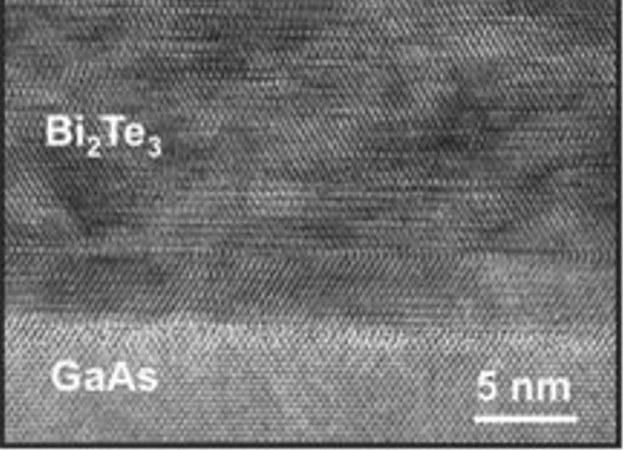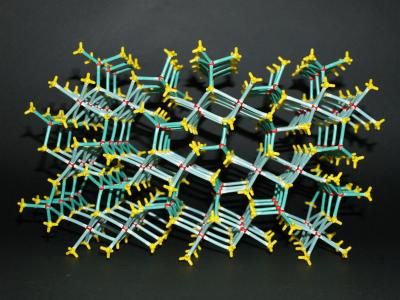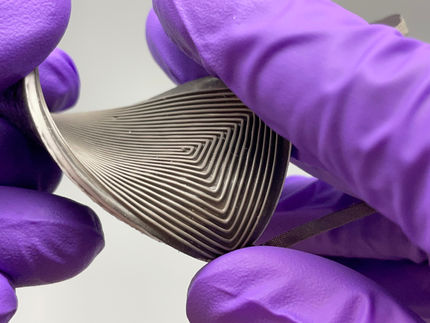Defects can 'Hulk-up' materials
Advertisement
In the story of the Marvel Universe superhero known as the Hulk, exposure to gamma radiation transforms scientist Bruce Banner into a far more powerful version of himself. In a study at Berkeley Lab, exposure to alpha-particle radiation has been shown to transform certain thermoelectric materials into far more powerful versions of themselves.

Cross sectional HRTEM image of bismuth telluride thin-film grown on gallium arsenide substrate.
Courtesy of Junqiao Wu, Berkeley Lab
"We've demonstrated that by irradiating a thermoelectric semiconductor with high-energy alpha particles, we can control native defects in the crystal so that these defects actually enhance the performance of the thermoelectric material by a factor of up to ten," says Junqiao Wu, a physicist who holds joint appointments with Berkeley Lab's Materials Sciences Division and the University of California Berkeley's Department of Materials Science and Engineering. "Although this discovery goes against common wisdom, it turns out that when properly managed, a damaged thermoelectric material is a better thermoelectric material."
The ability of thermoelectric materials to convert heat into electricity, or electricity into cooling, represents a potentially huge source of clean, green energy. Consequently, thermoelectric materials have been heavily investigated over the past several decades. Past studies have shown that the efficiency of heat-to-electricity conversion - a metric known as the "figure-of-merit" or ZT - is inherently limited by the coupling of three key parameters: electrical conductivity, thermopower and thermal conductivity.
"Usually thermopower is enhanced at the cost of a reduction in electrical conductivity," Wu says, "but we have been able to break this undesired coupling and demonstrate simultaneous increases in electrical conductivity of up to 200-percent, and thermopower of up to 70-percent."
By irradiating with alpha-particles thin-films of bismuth telluride, a well-characterized thermoelectric, Wu and his collaborators achieved a ZT value as high as 1.24, the highest rating ever recorded for bismuth telluride at room temperature.
"The alpha particles knocked out atoms from their lattice sites and introduced native defects such as vacancies and interstitials," says Joonki Suh, a member of Wu's research group and lead author of a paper describing this study (see below). "Normally, you would expect defects to degrade a material's performance, but the alpha particles inflicted relatively heavy damage beneath the surfaces of the bismuth telluride thin-films while allowing the surfaces to retain good electrical conductivity. The results were controlled native defects that acted beneficially and multi-functionally as electron donors and electron energy filters."
As they expect native defects to be generated and behave in a similar manner to what was accomplished with bismuth telluride across a wide range of narrow-bandgap semiconductors, Wu and his collaborators believe their technique can be used to improve the ZT values of other thermoelectric materials without the need for complicated and expensive materials processing.
"For example," Wu says, "one could use irradiation to improve the performance of thin-film thermoelectric devices that are potentially important for on-chip cooling of high-power electronics. One could also control the growth process of bulk thermoelectric materials to stabilize useful native defects."
In addition, thermoelectric materials are being groomed for use in radiative environments, such as outer space. The data provided by this study should provide helpful guidelines for the selection of future materials.
"From a fundamental science point of view, defects, especially native defects, have always been a focus of research in the materials sciences, but their role in coupled thermal-electrical transport, as well as in entropy-transporting in thermoelectric materials, has been poorly understood," Wu says. "Our work lays a solid foundation for a complete understanding of the physics behind these processes. It also serves as a reminder that defects in materials are not necessarily bad."
























































